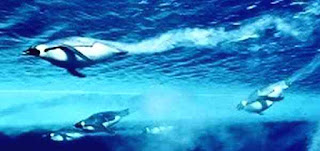A little penguin just flies through ocean water.
The little penguin (Eudyptula minor) literally flies through the water. It is uniquely adapted to live in the sea. The aerodynamically shaped wings of the penguin provide "flight" while their tiny legs are used as rudders.
The little penguin (Eudyptula minor) literally flies through the water. It is uniquely adapted to live in the sea. The aerodynamically shaped wings of the penguin provide "flight" while their tiny legs are used as rudders.
White bellies blend in when viewed from below. Dark blue on the back makes it difficult to pick out when seen from above. Short oily feathers insulate them from sea water.
little penguin summer
At night little penguins return to familiar colonies on land. Animals brought to Australia by Europeans are an imminent danger to them. Dogs, Cats and foxes will quickly snap them up.
penguin water
The birds use old burrows to breed. one parent sits on two eggs while the other gathers food. They alternate roles each day. As youngsters grow they remain outside the burrow waiting for parents to return to satisfy their ravenous appetites.
◆ Australiana ◆
●
ALL ARTICLES· ──► (HOME PAGE)
the flies feed off fish in the sea move out at dawn into the ocean




